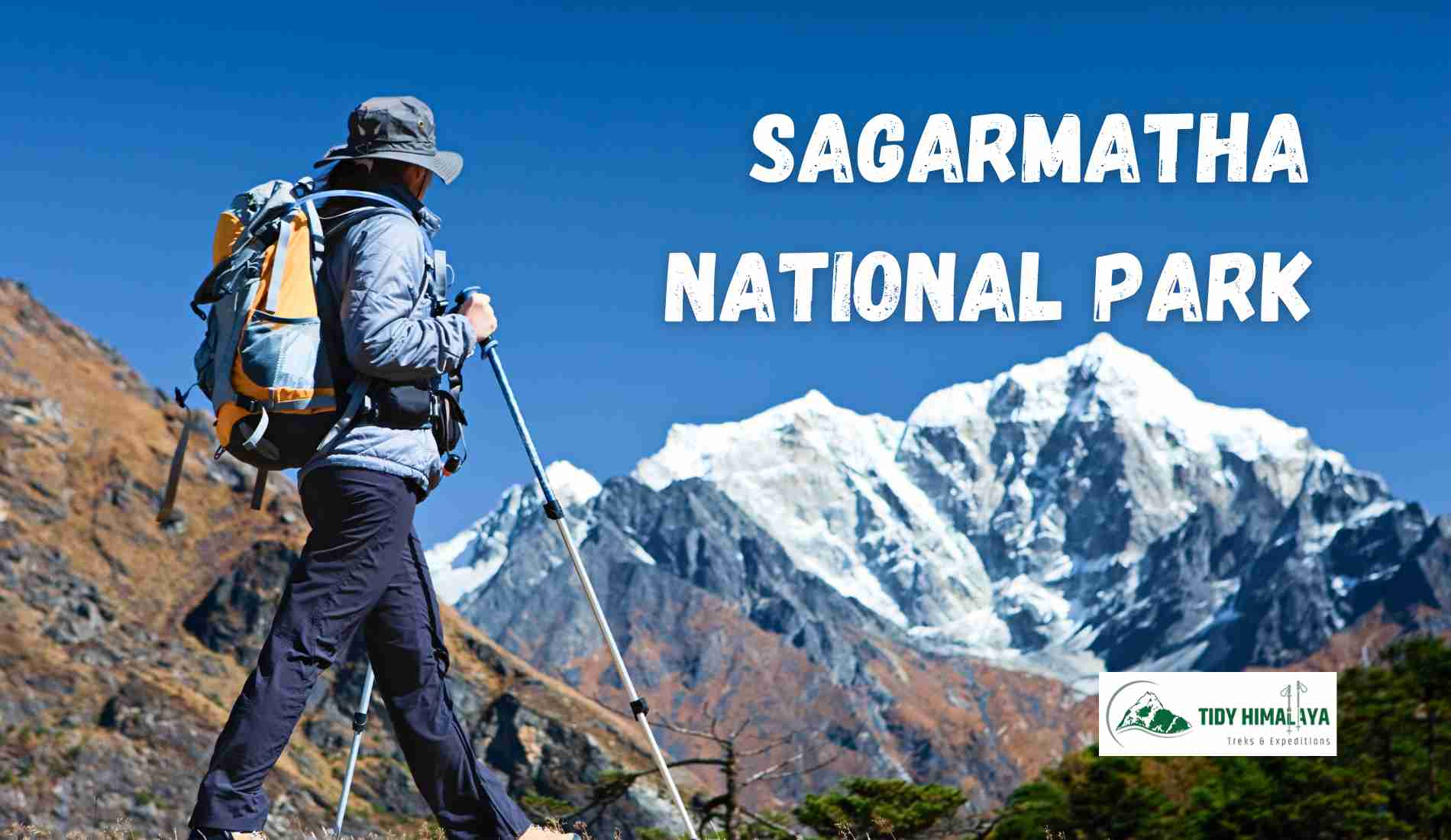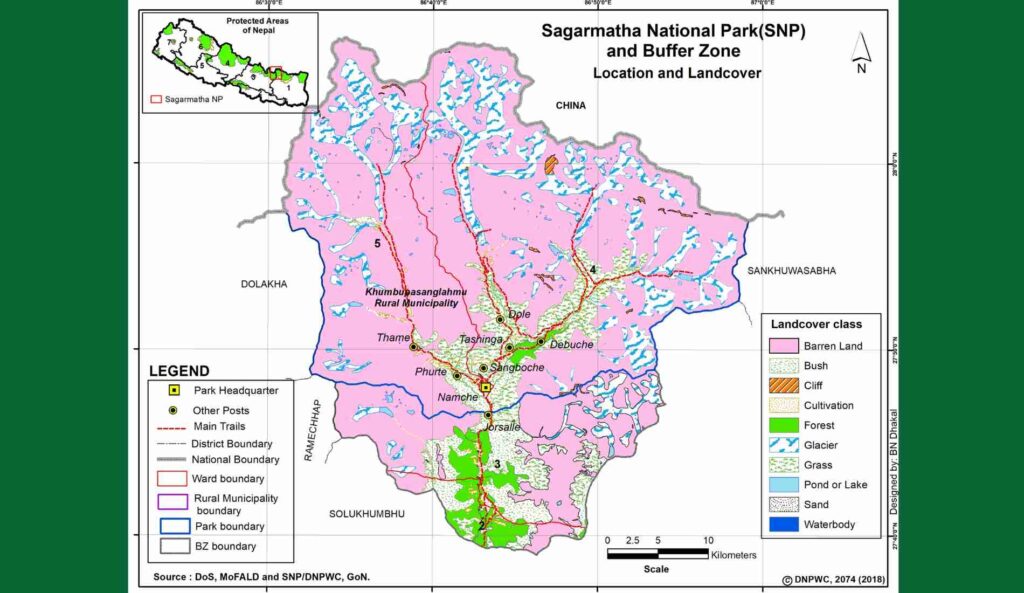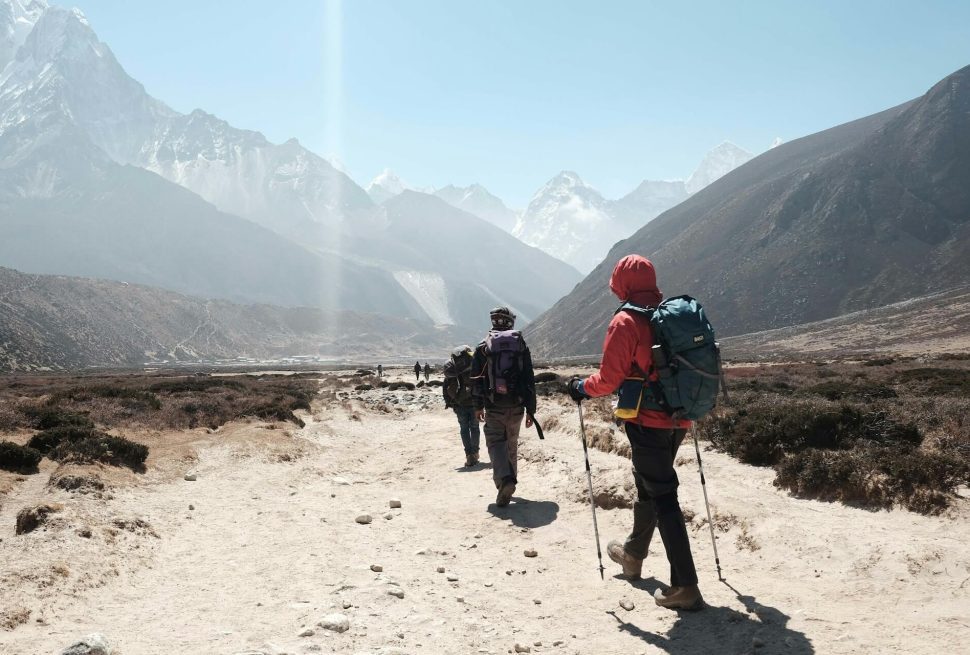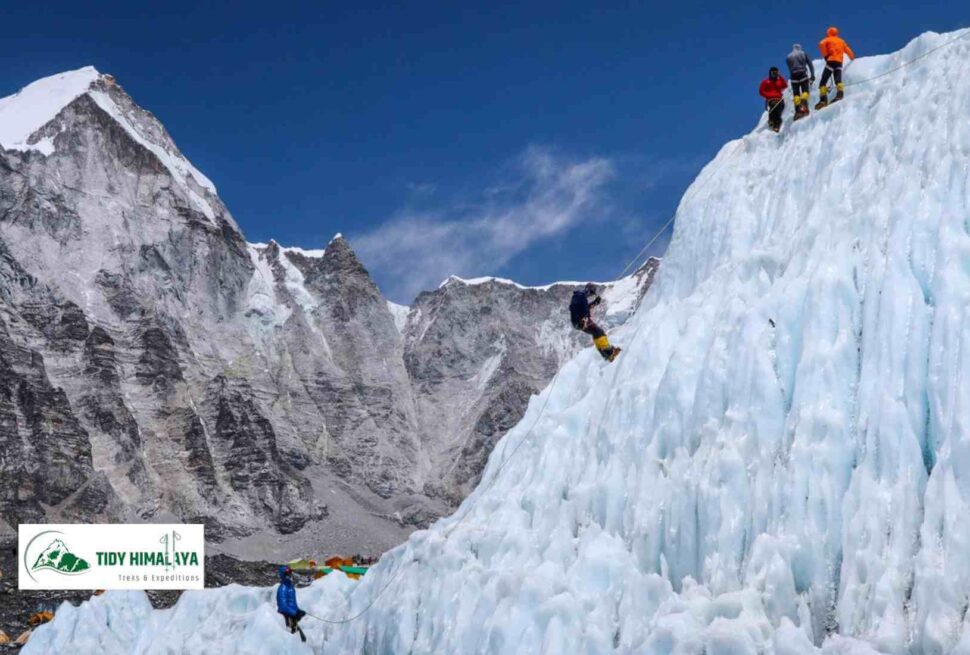The Solukhumbu District of northeastern Nepal is home to Sagarmatha National Park, a UNESCO World Heritage Site. With an area of 1,148 sk(square kilometer) (443 sm), it is home to the famed Mount Everest, sometimes referred to as Sagarmatha locally.
Sagarmatha National Park is a cultural treasure that captures the customs and tenacity of the Sherpa people. It is also a natural wonder because of its breathtaking scenery and wildlife, which has made it a popular trekking destination with 50,882 annual visitors(foreign tourists only) in recent years.
Popular 14-day Everest Base Camp Trek in SNP which begins in Lukla and ends at the Everest Base Camp, passes through several of the most famous spots in the Everest region, including Namche Bazaar, Hotel Everest View, Tengboche, Dingboche, Lobuche, Gorakshep, Kalapathhar, and lastly EBC. During the EBC trek distance, trekkers can enjoy breathtaking views of numerous peaks in the area, such as Mt. Everest, Pumori, Lhotse, Nuptse, Lobuche, and many more.
Thus, in this blog, we’ll discuss Sagarmatha National Park in great detail beyond Mount Everest’s pull.
Sagarmatha National Park in Detail
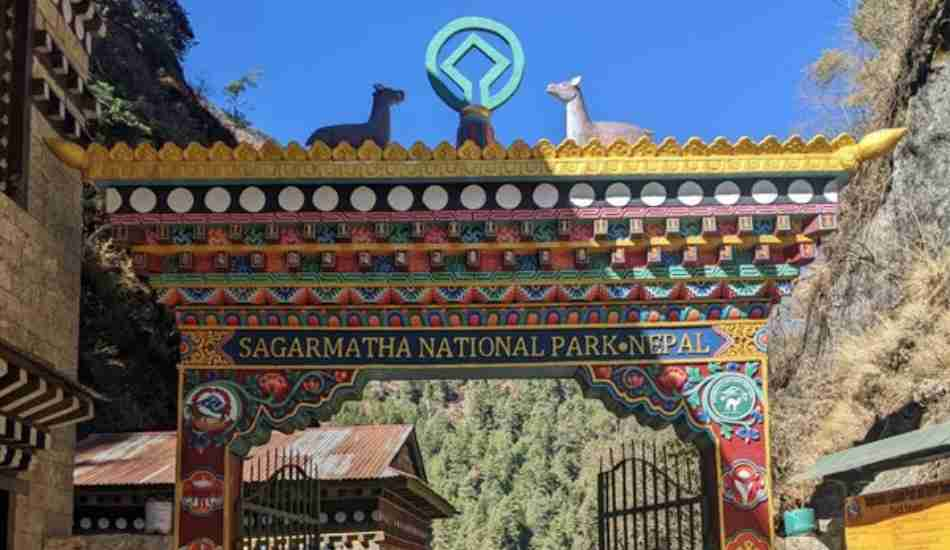
In Nepal’s Khumbu region, Sagarmatha National Park covers 1,148 sk (square kilometers) of the Himalayan ecological zone. With its breathtaking mountains, glaciers, and deep valleys, Sagarmatha is a unique region home to Mount Everest, the highest peak in the world at 8,848 meters above sea level, whereas Monjo is 2,845 meters high.
The famous Swedish explorer Sven Hedin discovered the centuries-old Tibetan name Cha-mo-lung-ma in the early 20th century. Consequently, Chomolungma, often spelled Qomolangma, is the historical, colloquial Tibetan name for Mount Everest, which means “Goddess Mother of the World.” Pronounce Chomolungma as “CHOH-moh-LUHNG-m?.”
Mount Everest is known as Sagarmatha in Nepali, which translates to “Goddess of the Sky.” While some consider Mount Everest the tallest mountain, others refer to the entire summit as Qomolangma (Everest, Nuptse, and Lhotse).
But even after all these years, “Mount Everest” remains the most well-known moniker worldwide.
The high Himalayas are home to rivers, rocky terrain, and gorges. Several endangered animals live in the area, including smaller pandas and snow leopards.
The area is also home to the well-known Sherpa people, whose lives are deeply influenced by Buddhist principles. The Sherpas’ presence and distinctive culture enhance the attraction of this location.
Religious holidays such as Mane Rumdu and Dumje are often celebrated at the well-known Tengboche and other monasteries.
Other notable monasteries in this area are Tengboche, Thame, Khumjung, and Pangboche. SNP was listed as a World Heritage Site by UNESCO in 1979 due to its exceptional natural features.
Weather and Geographical Structure
Due to its broad altitudinal range, the Himalayan environment of Sagarmatha National Park has a vast diversity of climates. The climate is humid subtropical at lower altitudes, whereas at higher altitudes, it is chilly and dry.
Lower altitudes have significant rainfall throughout the summer months of June through August. Winters, on the other hand, are cold and dry, with lows below freezing. They last from December to February.
On the other hand, cold conditions persist during spring (March through May), yet there is some sunlight.
In contrast, the sun completely vanishes from the sky during the autumnal season, which runs from September to November.
The most significant times to visit the Sagarmatha National Park, weather permitting, are October through November and March through May. The park mostly comprises the untamed landscape and gorges of the high Himalayas.
In Nepal’s Khumbu region, the Sagarmatha National Park spans 1148 square kilometers, including a buffer zone of 275 square kilometers. It is located in the Himalayan ecozone. It is the name of the tallest peak in the world. It is home to it i.e. 8,848-meter-high Mount Sagarmatha, also known as Everest.
An elevation range of 6,000 meters is part of the 124,400-hectare Sagarmatha National Park (SNP). Nuptse, Amadablam, Lhotse, Cho Oyu, Thamserku, and Pumori are some more peaks rising above 6,000 meters.
It is surrounded by the Dudh Koshi River in the south and the Bhote Koshi River in the east, and it is situated amidst the majestic peaks of the intricate Mahalangur sub-range.
Rugged terrain, frozen glaciers, towering peaks, and the deep canyons of the Himalayas are the prominent features of these landscapes. The breathtaking waterfalls, vast valleys, lovely lakes, and high-altitude passes top it all off.
Sagarmatha National Park Trails
Within Sagarmatha National Park, there are numerous trails and treks that aren’t all focused on conquering Mount Everest. Due to the high altitudes, rough terrain, steep inclines, and low oxygen levels, trekking in this region is difficult and best left to those in better physical shape.
You can expect to hike and journey for several days in virtually all cases. After extensive acclimatization, reaching Everest Base Camp takes 12 to 14 days.
How to Reach?
From Kathmandu, Sagarmatha National Park is roughly 137 kilometers away. Sagarmatha National Park can be accessed in a variety of ways.
The most popular method is flying to Lukla and hiking for two days. On the other hand, you can hike for ten days after riding up to Jiri. Hiking is five days shorter if you ride up to Salleri.
Another is to take a plane to Tumblingtar or Phaplu and hike for ten or five days, respectively. There is also the option of a direct helicopter ride to Namche Bazar, Kala Patthar, Everest Base Camp, and other park locations.
The following are the most popular routes from Kathmandu to the park headquarters in Namche:
- Travel to Lukla and a two-day hike
- Bus to Jiri and a ten-day hike
- Tavel to Phaplu and a five-day hike
- A trip to Salleri and a five-day hike
Season Overview
Best Seasons And Times to Visit Sagarmatha National Park
Determining the ideal time to visit Sagarmatha National Park helps you plan your trip more efficiently and prepare for the experiences and obstacles ahead.
Best Season:
1. October-November:
Weather: Clear skies, moderate temperatures.
Daytime Temperature: 10-15°C (50-59°F).
Ideal For: Trekking and mountaineering with excellent visibility.
2. March-May:
Weather: Blooming rhododendrons, gradually warming temperatures.
Daytime Temperature: 10-15°C (50-59°F).
Ideal For: Trekking amidst colorful flora and fauna.
Winter Season:
3. December-February:
Weather: Cold, snowy conditions.
Daytime Temperature: Around 5°C (41°F).
Ideal For: Experienced trekkers seeking solitude and snow-covered landscapes.
Monsoon Season:
4. June-September:
Weather: Heavy rain, high humidity.
Challenges: Muddy trails, potential for landslides.
Less Ideal For : Trekking due to poor visibility and challenging conditions.
October-November and March-May are the best times to visit Sagarmatha National Park for clear views and favorable trekking conditions. These seasons’ temperatures are tolerable compared to the bitter cold of winter. Even while this location does not get as severe monsoons, unexpected downpours are still possible.
Plants and Animals
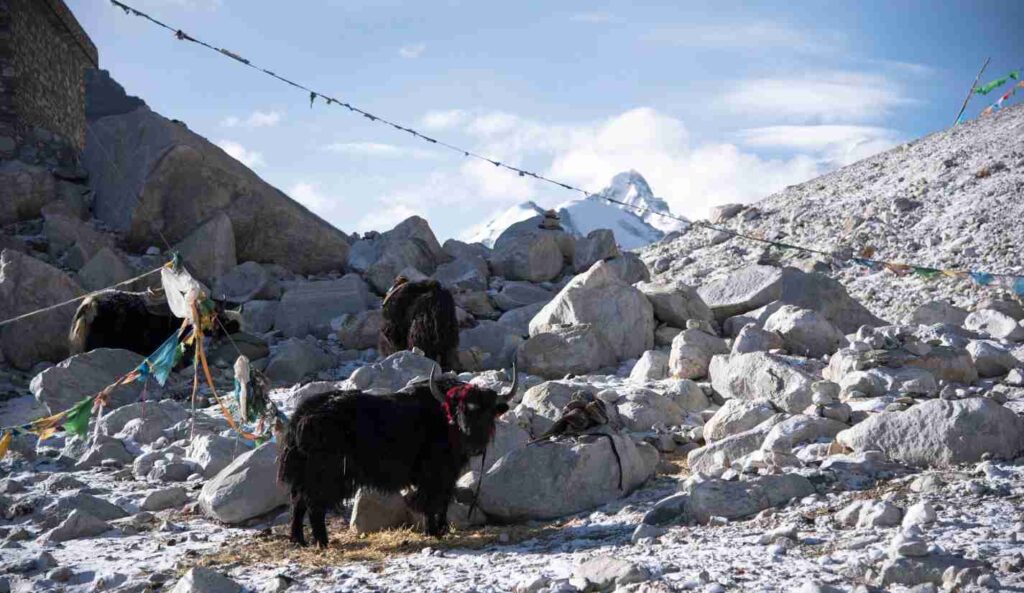
Within the Park, wooded areas spanning up to 4,000 meters are home to birch, juniper trees, blue pines, dwarf shrubs, firs, bamboo, rhododendron, pine, and hemlock forests at lower altitudes. However, only grasslands and cushion plants like mosses can be found at higher elevations (up to 6000 m).
However, Sagarmatha National Park has a smaller variety of species compared to other protected regions. This is a result of the arctic weather that this area experiences. With over 118 different species of birds, including the Impeyan pheasant, snow cock, red-billed cough, blood pheasant, and other avian species, the area is a haven for birdwatchers. In the same way, creatures such as Himalayan black bears, musk deer, wolves, etc.
Rare Himalayan species like red pandas and snow leopards can be found in the Park. Rhododendron forests, junipers, birches, and towering blue pines beautify the lower altitudes. As one ascends higher, alpine meadows begin to dominate the scenery.
During the field survey, two Himalayan Monals (one with sparking colors being male and another with sparking colors being female) were sighted in the SNP. These species prefer oak-conifer forests in upper temperate regions and oak forests in sub-alpine regions, combined with steep, grassy, and open rocky slopes, cliffs, and alpine areas.
The Local Populace at the Buffer Zone
The Nepalese government’s 2002 declaration of a buffer zone aimed at lessening biotic pressure on the Park’s slow-growing vegetation. Additionally, the government has mandated that 30 to 50 percent of park money be reinvested in community development initiatives within the buffer zone. It seeks to protect the region’s biodiversity in cooperation with the local population.
Popular trekking routes include the Namche to Kala Pathar route. There are also breathtaking vistas from the Chukung and Gokyo Lake valleys. While Phortse is well-known for its animal watching, the Thame Valley is famous for its Sherpa culture. Some of the high passes are worthwhile to cross. However, hikers need a guide and the right gear for the Everest Base Camp trek.
Sagarmatha National Park's Famous Attraction and Things to Do
1. Various Monasteries
Numerous monasteries are worth visiting because of the Tibetan influence and the prevalence of Buddhism in the area. Notable monasteries in the region include those at Tengboche, Thame, Khumjung, and Pangboche. Moreover, these monasteries are frequently the site of gatherings for festivals like Dumje, Mane Rumdu, etc.
2. Mount Everest
With its breathtaking mountains, glaciers, and deep valleys, Sagarmatha is a unique region that is home to Mt Everest, the highest peak in the world at 8,848 meters.
It is without a doubt the main draw of this area, drawing tourists from all over the world who come to experience its charm. Known locally as Sagarmatha, this peak is also a popular destination for pilgrims, as it is revered as the Mother Goddess of the world.
Adventures like mountain climbing trips are available at this peak. But scaling Mount Everest is a very difficult and dangerous task.
Mount Everest Fun Facts:
- Everest is older than sixty million years
- Every year, Mount Everest expands by about 44 millimeters.
- Climbing Mount Everest might cost anything from $32,000 USD to $92,000 USD.
- Summiting Everest takes approximately 39-40 days.
- Ten hours 56 minutes was recorded as the fastest Everest Summit.
- At 24, Kami Rita Sherpa was recorded as the most successful submission.
3. Trekking Routes to Everest Best Camp
Sagarmatha National Park is a trekking enthusiast’s dream come true because it provides a bucket list of experiences to suit the needs of both novice and experienced hikers hoping to go close to Everest.
Trekking along the Everest Base Camp is unquestionably one of the most popular activities in Nepal. It’s a culturally captivating experience that will leave you with lifelong memories.
You will have the chance to discover most of the National Park’s noteworthy landmarks during this hike. This one tour covers a range of experiences with nature and picture-perfect moments, crossing several high mountains, native Sherpa settlements, glaciers, and quaint tiny teahouses.
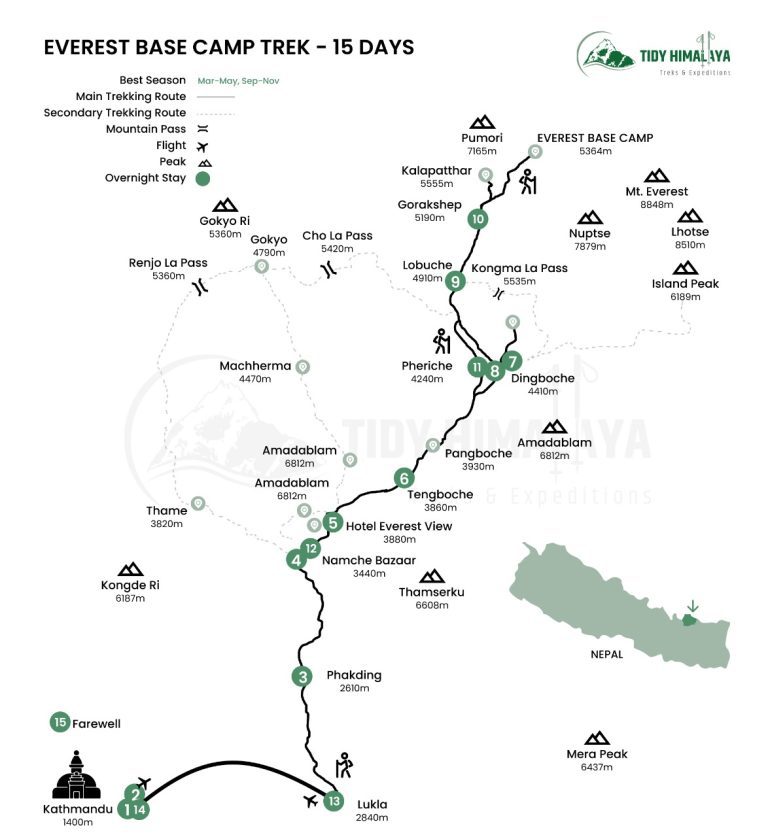
4. Gokyo Lake Trek
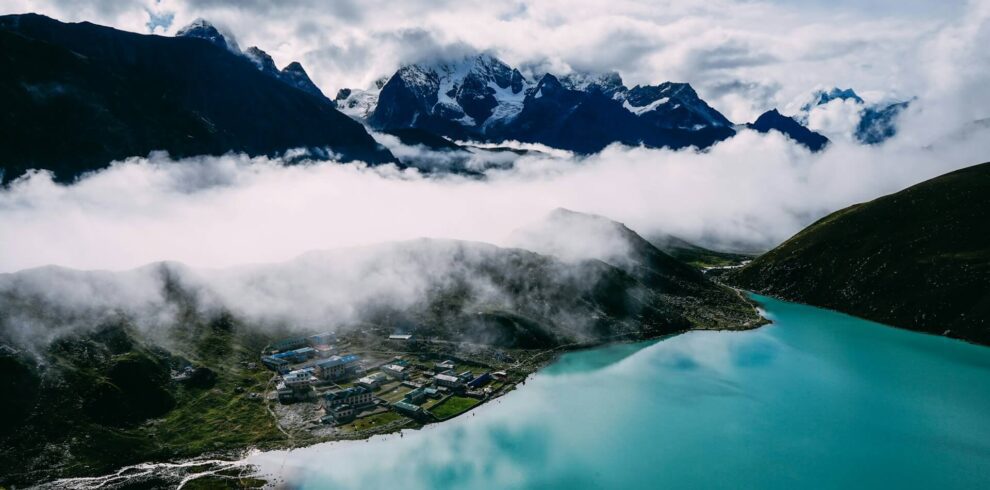
The Gokyo Ri hike in Sagarmatha National Park might be the best option for those looking to try something different. A stroll in Sagarmatha National Park offers a variety of Himalayan vistas.
There are six lakes in the Gokyo Lakes, with Lake Thonak being the biggest. A day spent in a park or camping near the lakes could be a fascinating experience because the region provides breathtaking views of the surrounding glaciers and mountains, especially the massive Everest.
Furthermore, this walk is simpler than EBC treks. The Gokyo Ri walk offers breathtaking views of Cho Oyu, Makalu, and Everest, bringing you deeper into the Park.
Hiking the Gokyo Lake trek offers breathtaking views from Gokyo Ri, other hidden valleys, and various blue glacier lakes. The Ngozumpa Glacier, the biggest glacier in Nepal’s Himalayas, is another landmark of the trek.
5. Everest Three Passes Trek
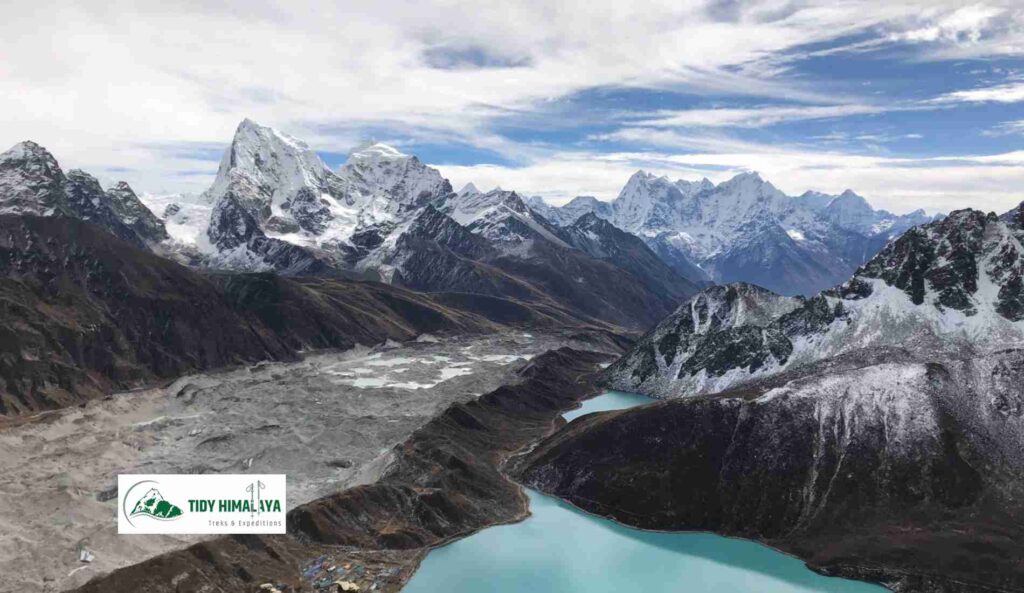
The Everest Three Passes Trek offers a once-in-a-lifetime opportunity to see the massive Himalayas rising to 8,000 meters. Cho Oyu, Lhotse, Makalu, and the highest peak, Mount Everest, are among them. The Ngozumpa Glacier is one of the biggest glaciers in the Nepal Himalayas.
We will witness the wonders of Gokyo Valley, which is home to several stone homes and meadows along Dudh Pokhari, a large lake. Most significantly, we will traverse the Kongma La Pass, Cho La Pass, and Renjo La Pass—the three high passes in the Everest region.
The breathtaking scenery from the Everest three-pass climb nearly brings everyone to their knees. It is similarly difficult, though. As such, this section of the climb offers some of the most breathtaking and daring experiences for trekkers.
6. Gokyo to Everest Base Camp Trek
The Gokyo to Everest Base Camp Trek, sometimes referred to as the Everest Circuit Trek, is an exciting journey over the Everest Himalayas. The path leads hikers to the 5,330-meter-high Cho La Pass, which enables them to access Mount Everest’s magnificent Base Camp.
Throughout the Gokyo Lake and Everest Base Camp Trek, you may enjoy amazing views of Everest and numerous other similar peaks. You will also be able to see the Buddhist monasteries located at the highest altitude on Earth. This hike takes you to the famed Sherpa people’s home, which is tucked away at the base of Mt. Everest, the world’s highest peak at 8,848.86 meters.
The route visits Lukla, Namche Bazaar, Gokyo, Cho La Pass, Kala Patthar, and, lastly, Everest Base Camp. It takes the well-known trekking path via Dudh Koshi and on to Gokyo Lake, the source, which is located west of Everest Base Camp.
7. Khumbu Glacier and Icefall
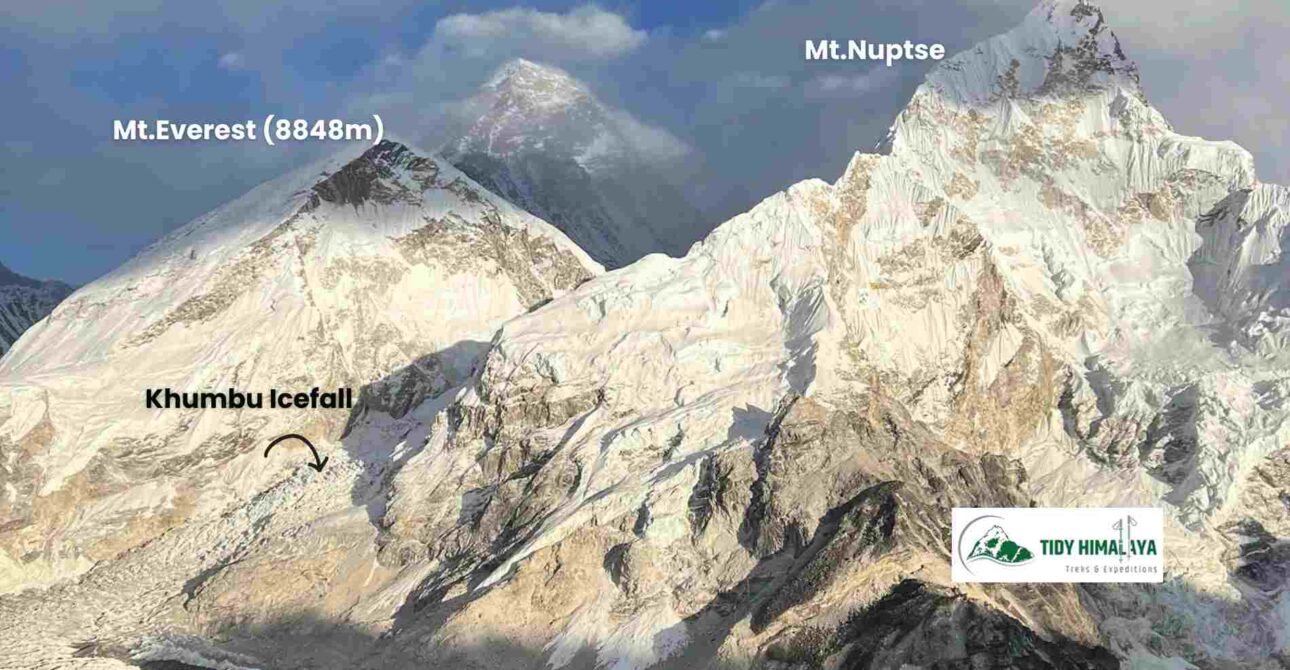
The Khumbu Glacier is also one of the highest glaciers in the world, rising to a height of 7,600 meters (24,900 feet) at its source. It’s also Nepal’s biggest glacier. It is part of the ascent route to the summit of Mount Everest, the Khumbu Icefall, which is situated in Nepal on the mountain’s southern flank.
This is the most perilous part of the ascent because of the enormous ice blocks known as seracs, deep crevasses, and constantly moving ice. This glacier is made up of the Khumbu Icefall, which is located at the westernmost point of lower Western Cwm. Climbers who choose to ascend Everest by the southern normal route face significant challenges due to this icefall. On their final leg, hikers follow the Khumbu glacier to the Everest base camp.
8. Mount Ama Dablam
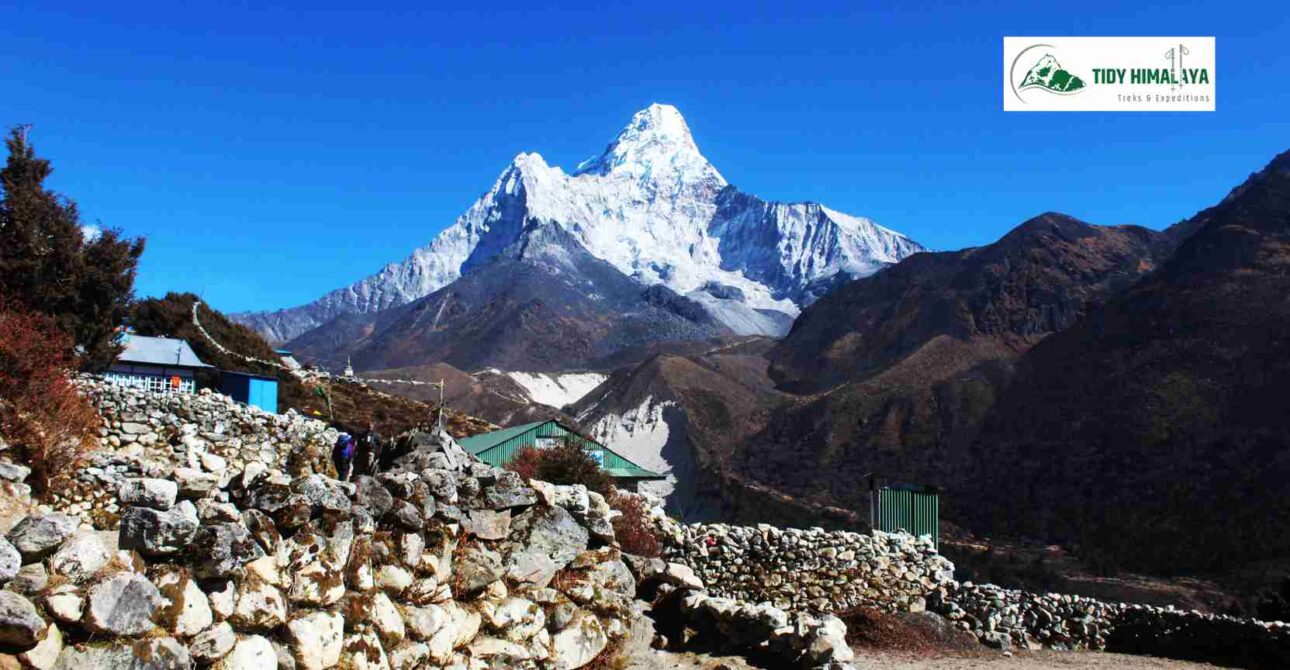
Mt. Ama Dablam is another mountain that may be seen along the route to Everest Base Camp. Its name, which translates to “Mother’s Necklace” in the local language, was present in it due to its unusual structure. Even though the trip to the summit demands sophisticated mountaineering skills, the trail itself offers an amazing vista.
Sometimes referred to as the “Matterhorn of the Himalayas,” Ama Dablam is named for its towering ridges and steep sides. The mountain is featured on the Nepalese currency worth one rupee.
With a tricky path that combines ice climbing, rock climbing, and high-altitude mountaineering, Ama Dablam (6810 meters) is regarded as one of the most difficult mountains to climb. Technical climbing gear, including ropes, ice axes, crampons, ice screws, cams, and jumars, are needed for this adventure.
9. Kala Patthar, the Viewpoint
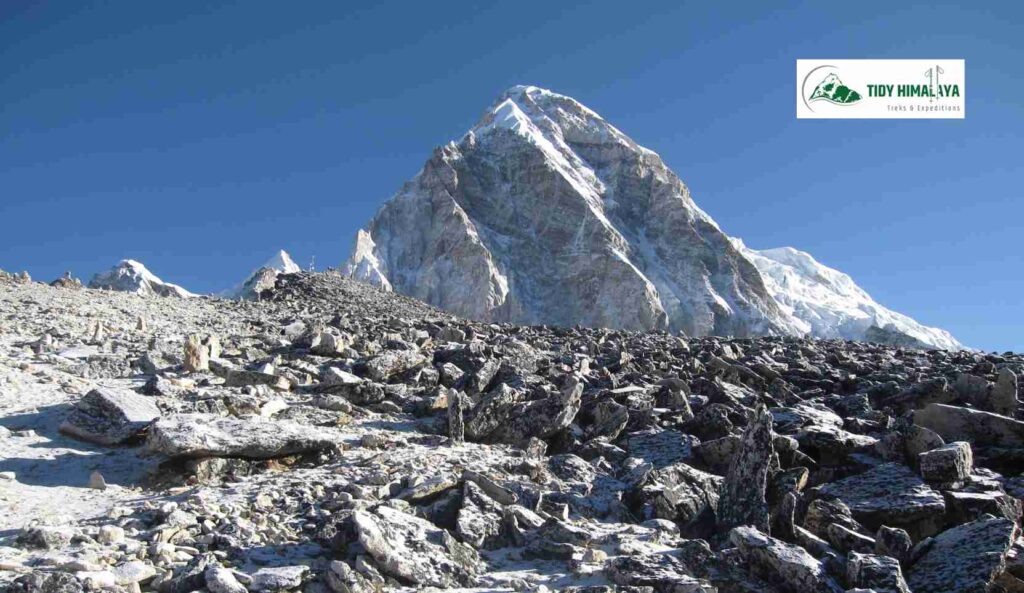
The Kala Patthar viewpoint is visited by most trekkers who trek to Everest Base Camp before returning to Lukla. Kala Patthar is the highest point in Nepal, and a climbing permit is not required. However, the thin air and high altitude make it a challenging climb.
Kala Patthar gives trekkers a remarkable vantage point to witness the majesty of Everest. As a remarkable landmark, it’s a must-go for adventurers and nature fanatics alike. Kala Patthar is outfitted with a camera and is regarded as the greatest camera on the globe.
Mountaineering Journeys
While the towering Himalayan giants are the main attraction in Sagarmatha National Park, mountaineering trips have arisen as an obvious but surprising attraction.
Numerous climbers have made similar attempts to reach the top of the world since 1953, when the first person set foot on it. While some of them were successful, others were unable to overcome their personal shortcomings or the inclement weather.
Every professional climber desires to reach the top of Mount Everest and to achieve this goal; they are willing to make significant time and financial sacrifices. But none can do that on their own; instead, they require the assistance of numerous other people who they can trust. These individuals are qualified guides and organizers who oversee the safety of climbers and the planning of the Mt. Everest trip.
1. Mount Everest Climbing

Many climbers, including very experienced mountaineers, are drawn to Mount Everest. The “standard route” approaches the summit from the southeast in Nepal, while the other approaches it from the north in Tibet. These are the two main routes for climbing.
Climbing Mount Everest is the ultimate Everest adventure for those whose adrenaline rush isn’t fulfilled by a simple hike to the mountain’s base.
Experience level
You must be a skilled climber who possesses:
- At least 7000 meters of altitude experience (a summit of Aconcagua suffices)
technical expertise, self-assurance, and - A track record of crampons, glacier and fixed-line climbing
- Able to handle harsh environments and icy and sharp rocks with ease
- A comprehensive résumé detailing your climbing experience (if you would like to see if it is appropriate, please feel free to contact us with your climbing experience)
2. Lobuche Climbing
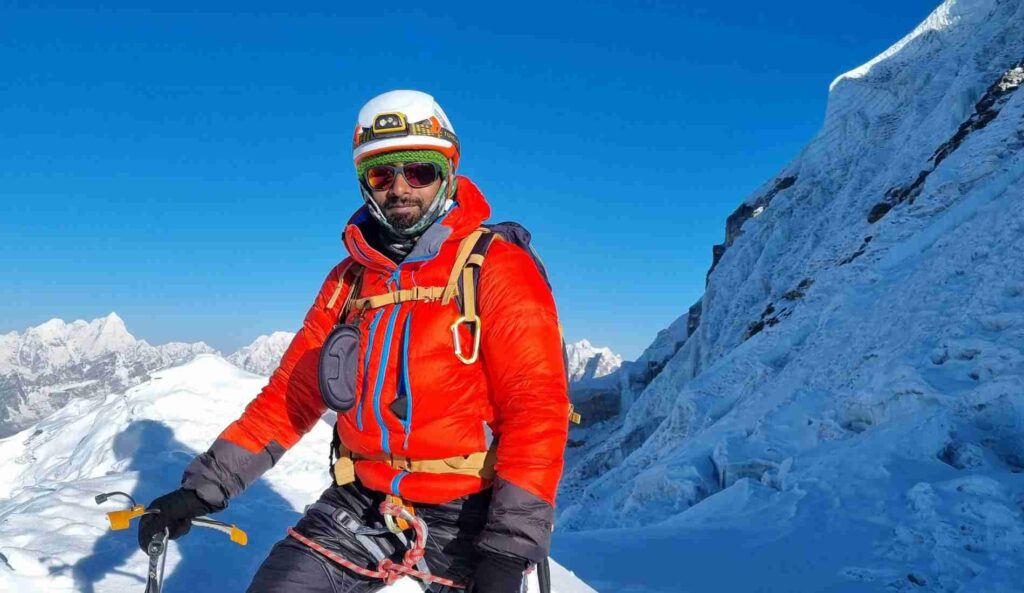
Lobuche Peak is easily accessible and requires only a modest level of technical competence to ascend, so it is a popular choice for many climbers. It is notable for providing uncommon sweeping views of Everest, which are rarely available from other heights, such as Island Peak.
The breathtaking trekking experience is enhanced by the climbing expedition starting from the path leading to Everest Base Camp.
For those who want to experience mountaineering, climbing the well-known Lobuche Peak, which stands at 6,119 meters above sea level, is an exciting although less taxing endeavor compared to climbing other, more challenging summits. The route up Lobuche Peak is difficult, blocked at times by snow and large rocks that require the use of ropes to climb over precipices.
3. Island Peak Climbing
Climbing island peaks in Nepal give you the chance to reach the 6,187-meter-tall Imja Tse, which is in the middle of the country’s busy Khumbu Himalayan range. This mountain is a popular travel destination, drawing in both experienced travelers and committed climbers who seek the ultimate sense of fulfillment and achievement.
The trip to the charming village is the first leg of the island peak climbing adventure from Chhukung. From there, the trail goes to the Island Peak base camp, providing a dual opportunity to see the natural world and take on a challenging adventure.
For individuals who wish to get ready for more challenging mountain experiences without sacrificing the best views from the summit of a mountain, this is the ideal experience.
Planning your Visit to Sagarmatha National Park
Permits and Regulations

- Access to Rs. 3,000 (foreigners), Rs. 1,500 (SAARC Nationals), Rs. 100 (Nepali) travelers, and Rs. 25 for traveler porter ought to be paid at the detailed price tag counter.
- Valid access lets in are to be had from the National Park price price tag counter on the Nepal Tourism Board, Bhirkuti Mandap, Kathmandu or park front gate at Manjo.
- The access allowed is non-refundable, non-transferable, and is for an unmarried access handiest.
- Entering the Park with out a allow is illegal. Park employees may also ask for the allow, so site visitors are asked to preserve the allow with them.
- Get unique and allow for documentary/film from the Department of National Park and Wildlife Conservation (DNPWC).
- Documentary/ filming prices of US$ 1500 (Foreigners), Rs. 50,000 (SAARC Nationals), and Rs. 10000 (Nepali) ought to be paid at DNPWC. An additional 25% ought to be paid for the usage of drones for documentary/ filming.
- Drone (UAV) price is identical to documentary/filming price whilst the usage of it for different purposes.
- Don’t put off or harm vegetation and animals. All vegetation and fauna are completely covered and need no longer be disturbed.
- Rubbish needs to be positioned out, buried, or disposed of in detailed areas.
- No one ought to stroll inside the Park between sundown and sunrise. Do admire the cultural and spiritual sites.
- Visitors ought to be self-enough in gas supply (Kerosene/ LP Gas)
- Camping in the Park ought to be made handiest on the detailed areas.
- Carry out non-biodegradable gadgets, including batteries, plastic baggage, and bottles.
- Mountain motorcycles are prohibited in the SNP.
> Read our detailed guide on Nepal Trekking Permit
Additional Tips
- Generally speaking, it is anticipated that visitors won’t damage or disrupt the area’s protected plants and animals.
- The “leave no trace” philosophy must be practice, and responsible tourism must be guaranteed. Nothing in the park area should be used for trash disposal.
- Sagarmatha National Park’s environment is as delicate as it is. It is therefore advised that you assist with waste management by taking some of the trash out with you while you explore.
- There are strong cultural values in this area. It is therefore strongly advised that guests learn about and respect the customs and culture of the area. It’s best to dress modestly, especially while visiting places of worship.
Issues with Sagarmatha National Park's Conservation
Sagarmatha National Park’s fragile ecosystem is facing difficulties as a result of rising human activity and climate change. Beginning in the 1960s, Sagarmatha National Park (SNP) has seen an annual increase in the number of visitors.
Three thousand six hundred (3,600) people came to SNP in 1979; by 2010, that figure had risen to 25,000. According to the most recent data, 57,690 people made trips to the Everest region in 2022. This area is facing environmental issues as a result of the tourist inflow. Therefore, conservation initiatives are being carried out in support of eco-friendly tourism.
Requirements for Management and Protection
The National Park and Wildlife Conservation Office, Department of National Parks and Wildlife Conservation, Ministry of Forests, Government of Nepal, is in charge of managing Sagarmatha National Park, which was created on July 19, 1976, in accordance with the National Parks and Wildlife Conservation Act. The Himalayan National Park Regulations of 1978 and the National Park and Wildlife Protection Act of 1973 both maintain effective legal protection.
The majority of the Park (69%) is made up of arid territory over 5,000 meters, with 28% being grazing pasture and roughly 3% being wooded. This, together with the Sherpa population’s reliance on agro-pastoralism for livelihood, presents a variety of management issues.
A group of experts working for the Department of National Parks and Wildlife Conservation oversee and carry out the 2007–2012 Management Plan, which has been approved by the Nepalese government, for the property and its buffer zone.
The government is still carrying out the Management Plan, but more work is required to lessen the effects of several problems that are common at the property. These problems include issues with tourism management that have an impact on the property’s values, as well as the encouragement of environmentally friendly practices that reduce pollution and promote sustainable use of the Park’s natural resources.
After the buffer zone program was put into place, local communities’ ongoing support and involvement in conservation and management has been a reassuring turning point for the management of SNP. The local economy has been boosted by the sharp rise in yearly tourist numbers, but the delicate environment and cultural traditions of the area are also being further harmed.
Even with the small number of operating micro-hydro projects providing an alternative to firewood, the property’s delicate mountain forest environment is nevertheless being degraded as a result of the ongoing and growing need for firewood.
To Conclude
Sagarmatha National Park’s grandeur extends way beyond the Himalayan region’s investigation. This trip offers a wonderful symphony of cultures, wildlife, adventures, and scenic splendor. Every step you take in this Park takes you deeper into the heart of the Himalayas, from the imposing peaks to the vibrant cultural tapestry.
A trip to Sagarmatha National Park is an investigation of the mind-blowing marvels of nature, not merely an adventure. You’re in for an incredible journey with Sagarmatha. Our knowledgeable guides will ensure that you will see every important location within Sagarmatha National Park along the route to your trip destination, which includes Everest Base Camp.
To preserve the sanctity of this fragile place, take care to walk carefully there.

